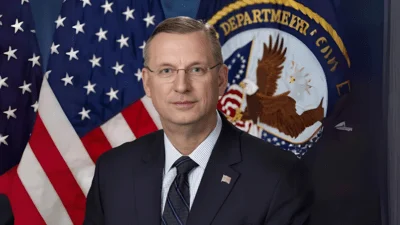Assistant Secretary for Industry & Analysis Grant Harris at the 2023 Annual Hydrogen and Fuel Cell Seminar
February 8, 2023
As Prepared for Delivery
Good morning!
I’m so pleased to join the Hydrogen and Fuel Cell Seminar on behalf of the U.S. Department of Commerce– this is a first for me.
Thank you, Frank, for the kind introduction. It’s an honor to be here with you and with such outstanding attendance.
And a huge thank you to the Fuel Cell and Hydrogen Energy Association for organizing this event, one of the most impactful and longest-running conference and exposition for the hydrogen sector in North America.
I would also like to thank the great State of California, my home state, not to mention the world’s fifth largest economy and a growing clean energy powerhouse that has consistently led on environmental and energy policy issues.
I would be remiss if I did not thank the public and private sector leaders in climate change and hydrogen technology for joining us today. While our roles vary, our commitment to clean energy and clean tech unite us and the timing for us to hear from each other could not be better.
As you know, the Biden-Harris Administration is leaning hard into critical legislation that is proving invaluable to the clean energy transition and putting wind in the sails of the hydrogen industry.
President Biden promised to take bold action on climate change. Through the historic steps taken to implement three landmark pieces of recent legislation – the CHIPS and Science Act, the Bipartisan Infrastructure Law, and the Inflation Reduction Act, the President’s leadership has put us on a credible course to deliver on the promise of a net zero economy by 2050.
Thanks to this Administration’s clean energy and climate agenda, last year marked the largest deployment of solar, wind, and batteries in United States history, and our nation is now a magnet for investment in clean energy manufacturing.
Over the last two years, the private sector has committed over $100 billion in new private capital to make electric vehicles and batteries in the United States. We have made historic investments in clean hydrogen, nuclear, and other cutting-edge technologies. And companies are investing billions more to grow a new domestic offshore wind industry.
While other elements of the energy transition often get more airtime, I know that the folks in this room are confident in the byline of this story: hydrogen is emerging as a central player in the fight against climate change for its potential to complement electrification in decarbonizing our economy.
The challenge to deploy hydrogen infrastructure is one that will require the focus and attention of everyone in this room. The prize of a fully developed hydrogen economy is unmistakable, and historians may well look back upon the hydrogen infrastructure that we build in the coming years with the same reverence given prior renowned public works projects, such as the national interstate highway system and as a pivotal contribution to our ambitious climate agenda.
This hydrogen wave is the result of decades of investment in research and effort from pioneers in the industry – investments funded in large part via public resources. Commerce’s International Trade Administration, or ITA, realizes the increasingly important role it has in supporting the development of private industry entering “first” or nascent commercial markets.
To advance the Administration’s climate and trade agenda, ITA focuses on four strategic objectives:
Our first objective is to promote U.S. exports and inward investment and help States including California create well-paying jobs.
ITA brings all of its resources to bear to support American manufacturers and help American workers lead the global market in the production of climate-related technologies and low-carbon solutions. Through a wide array of well-targeted export promotion programs, including business development missions, trade shows, and matchmaking events, ITA helps connect U.S. companies with international buyers and partners looking for cutting-edge climate solutions and facilitates business investment into the United States.
Our second objective is to remove, reduce, and prevent trade barriers.
Through its commercial diplomacy efforts, ITA promotes policies in foreign markets to enable trade and investment in climate related technologies and low carbon solutions. This includes reducing or eliminating tariffs maintained by our trading partners, advocating for a transparent and predictable regulatory climate, supporting intellectual property rights protection and enforcement, and seeking the adoption and implementation of strong, industry-led standards. These policies not only facilitate greater market access for U.S. firms, but also ensure a conducive business climate for local businesses and help nations better integrate into global supply chains.
Our third objective is to enforce trade laws and agreements.
ITA’s enforcement and compliance efforts help eliminate harmful foreign government-imposed trade barriers and keep foreign markets open and accessible to U.S. exports and investments while ensuring that our trading partners live up to their commitments to maintain robust environmental protections, as per the terms of U.S. trade agreements.
Our fourth objective is to support U.S. companies competing for foreign projects.
ITA advocates on behalf of U.S. exporters of low-carbon solutions competing in foreign government tenders and encourages fair and transparent procurement practices to level the playing field for U.S. companies. These efforts support hundreds of thousands of U.S. jobs.
For all these objectives, ITA leverages U.S. industry input to inform climate priorities and workstreams.
At the heart of our roadmap to help tackle the climate challenge and our mission of supporting U.S. businesses and workers through exports, is the U.S. Clean Tech Export Competitiveness Strategy.
Through this initiative, ITA is working to enhance our support for exporters of clean energy technologies by developing targeted trade missions, strengthening international clean tech standards, attracting foreign direct investment to grow domestic manufacturing capacities, and aligning commercial dialogues with our trading partners to maximize new commercial prospects for U.S. companies.
As a result of this work, over the past year ITA has organized more than 170 events focused on reaching and promoting U.S. clean tech exporters. Our export promotion and advocacy efforts have facilitated U.S. company participation in more than $3.2 billion dollars in climate and clean tech projects abroad.
Fortunately, the United States currently has a large degree of independence in terms of hydrogen supply chains.
However, we expect our interdependence with other regions to grow as this industry scales in the years to come, making the work I just described even more important.
Clearly there is a vital task at hand to promote a fair, rules-based system for international trade to help ensure that the hydrogen industry can scale up as efficiently as possible.
This task is not at all trivial. It comes down to the need to construct and support an infrastructure for the global commoditization of clean hydrogen. There’s room for all on this project.
And entrepreneurs such as yourselves need to continue to identify the opportunities to take hydrogen technologies to scale.
The hydrogen industry is unfolding before our eyes. I congratulate each of you for recognizing the opportunity to invest, to innovate, and to create new jobs and new opportunity.
Together, we can build a cleaner, more sustainable, and more prosperous future for all.
Thank you.
Original source can be found here.








